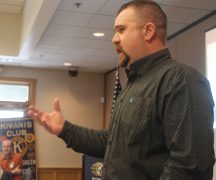By JAN LARSON McLAUGHLIN
BG Independent News
Many northern Ohio farmers have already taken steps voluntarily to cut down on toxic algae blooms – but not enough, according to researchers.
The U.S. and Canada have agreed to cut phosphorus discharge into Lake Erie by 40 percent in the next decade. But that goal won’t be met unless more farmers make some changes, according to researchers from Ohio State University.
The OSU project found that the following steps by farmers would help reach that 40 percent reduction in phosphorus discharge, which feeds toxic algae in the lake:
- Apply fertilizer below the soil surface.
- Plant cover crops which prevent rain from washing fertilizer into waterways. These crops are grown in fields that would otherwise go unplanted.
- Plant buffer strips, with grass or non-crop plants surrounding the fields. These also keep the fertilizer from going into ditches or creeks, and ultimately into the lake.
The OSU study found that 39 percent of farmers in the Lake Erie watershed already use subsurface fertilization, 22 percent grow cover crops and 35 percent plant buffer strips.
Those steps have all been taken on a voluntary basis by farmers.
However, those efforts are not enough, according to the researchers. To cut the phosphorus discharge in Lake Erie by 40 percent, each of those three preventative steps must grow by at least 20 percent.
“A lot of farmers have already taken the risk … to help move the needle,” Jay Martin, project leader and director of OSU’s Field to Faucet water quality program said recently, according to the Associated Press. “That’s really encouraging. But we need to accelerate.”
When contacted this week, Martin expressed optimism that voluntary efforts by farmers in this region of Ohio can result in the difference needed.
According to Martin, information from surveys of farmers in the Maumee watershed shows there is great potential for farmers to reach the needed levels of adoption.
“The surveys we have completed show likely future adoption rates for these practices exceeding these needed levels,” Martin said.
“It’s also important to note that many farmers have already adopted these practices, as demonstrated by current adoption rates of 39 percent for subsurface placement of phosphorus fertilizer and 22 percent for cover crops,” Martin said. “With continued and accelerated adoption of these practices, it appears we can reach reduction targets.”
Martin predicted more farmers will get on board once they see the value of the buffer and fertilizer practices.
“Our surveys also tell us that one of the most important factors farmers consider while evaluating these management practices is perceived efficacy,” Martin said. “Farmers are more likely to adopt practices that they are confident will be effective at reducing phosphorus leaving fields.”
To prove the effectiveness, several agricultural groups have introduced programs to test and demonstrate how these practices work, according to Martin. Two programs that are being led by Ohio Farm Bureau Federation, OSU Extension, Ohio Department of Agriculture and USDA are the Fertilizer Applicator Certification Training (FACT) and Blanchard River Demonstration Farms Network.
Through the FACT program more than 11,000 fertilizer applicators have learned about the latest methods to apply nutrients and minimize runoff, Martin said. The demonstration network includes three private operations that have adopted many nutrient management practices and regularly host field days so that others can see these practices in action and ask questions about their installation and operation.
“Programs like these are ways to increase farmers’ confidence and knowledge about management practices to reduce the movement of fertilizers,” Martin said.





